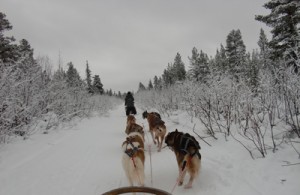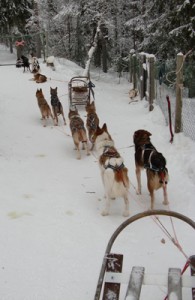February 2012
 I have always been a little nervous of dog sledding; I have visions of the dogs taking control and rushing off in the direction they want to go rather than where I want them to take me.
I have always been a little nervous of dog sledding; I have visions of the dogs taking control and rushing off in the direction they want to go rather than where I want them to take me.
In fact, the hardest part of it is putting on all the gear you need to protect you from the cold. Whatever ski wear or cold climate gear you buy in the UK really does not do the job in temperatures of minus 20 degrees and more. So, when you go on a dog-sledding excursion, you are provided with really heavy cold-weather gear (a bit like baby-grows for grown-ups), plus heavy boots and huge mittens to protect from the cold and the wind. A balaclava is also useful, or something to cover your face.
B-O, our dog sledding guide, has worked with dogs for most of his life. He is definitely the pack leader and they all look up to  him. Just a look or a brief command from him is all that is necessary. Six dogs will pull my sledge and there are two of us on it, one driving and the other sitting. The sledge is wooden and looks primitive. If you are driving, you stand on the two runners that extend from the back. You do not have reins of any sort, you just basically hold the metal bar which forms the top of the seat on which your passenger is sitting. You have a primitive but very effective brake on which you stand to apply pressure. This digs into the snow to slow down or stop the sledge. You swing to the left or right by simply leaning your body in that direction and the dogs sense that they should take a left or a right turn. If you have a sharp turn, you brake hard going into the bend and then release the brake as you are coming out.
him. Just a look or a brief command from him is all that is necessary. Six dogs will pull my sledge and there are two of us on it, one driving and the other sitting. The sledge is wooden and looks primitive. If you are driving, you stand on the two runners that extend from the back. You do not have reins of any sort, you just basically hold the metal bar which forms the top of the seat on which your passenger is sitting. You have a primitive but very effective brake on which you stand to apply pressure. This digs into the snow to slow down or stop the sledge. You swing to the left or right by simply leaning your body in that direction and the dogs sense that they should take a left or a right turn. If you have a sharp turn, you brake hard going into the bend and then release the brake as you are coming out.
B-O explained that he chooses the dogs according to the weight of the driver and passenger. He tells you this afterwards, of course, so as not to cause offence! Not all dogs can be leaders and not all dogs can run just in front of the sledge. The risk for the two dogs in front of the sledge is that, on a steep downhill and with an inexperienced driver who does not brake in time, the sledge can accelerate and hit their rear legs. The two dogs nearest the sledge are also the strongest.
 B-O’s dogs were very well behaved and patient. They loved being petted and fussed and just could not wait to get going. There were three teams, with B-O leading and carrying the all-important lunch box. The experience is magical, with the only sounds being the hiss of the sledge runners on the snow and the rattle of the harness. You don’t hear the dogs – they just work away at a steady gait, sometimes grabbing a mouthful of snow from the side of the path as they go. It only takes five minutes or so to turn the theory of what you have been told into practice and from there on, it’s simply exhilarating.
B-O’s dogs were very well behaved and patient. They loved being petted and fussed and just could not wait to get going. There were three teams, with B-O leading and carrying the all-important lunch box. The experience is magical, with the only sounds being the hiss of the sledge runners on the snow and the rattle of the harness. You don’t hear the dogs – they just work away at a steady gait, sometimes grabbing a mouthful of snow from the side of the path as they go. It only takes five minutes or so to turn the theory of what you have been told into practice and from there on, it’s simply exhilarating.
Of course we were following the leader. How I would manage on a long trek on my own is another matter! I was recently talking to the explorer/adventurer Benedict Allen, who had attempted to cross the Bering Straits from Russia to Alaska by husky sled. He described how important it had been to get the dogs to obey him and how long this took. He finally had to turn back as the conditions became so extreme that he felt he was putting both his and the dogs’ lives in danger.
So, I still have a long way to go and, judging by the doubtful looks the two dogs in front of me gave me every so often – I’m sure they weren’t confident that I knew what I was doing – it will take many such trips before the dogs are likely to have trust and confidence in my abilities.
Read about holidays in Northern Sweden





Sounds fantastic! This is on my list of Thing To Do Before I Die!